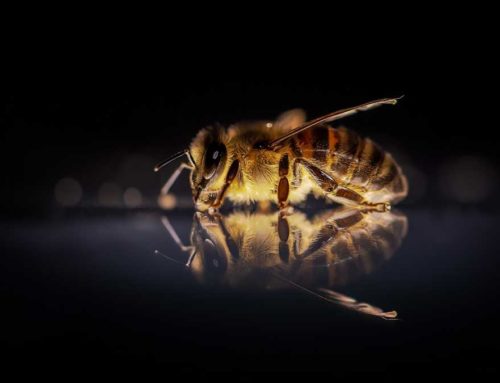Throughout human history, bees have been a part of daily life. In fact, they’ve been around for a lot longer than that, but I won’t ruin the rest of the article for you.
We are fascinated by all aspects of bees and beekeeping, from their biology, to their vital role in human existence – past and present. We’ve compiled 50 of the most interesting facts from the last 130 million years or so, some of which you may know, and some which may be a surprise even to the veteran beekeeper. Which leads us nicely onto number 1…
- Bees have existed for around 130 million years and have 4 life stages: egg, larvae, pupae, and adult.
- Bees have 5 eyes – 3 simple eyes, and 2 compound eyes.
- Hives produce 5 distinct substances: honey, beeswax, propolis, pollen, and royal jelly.
- In Ancient Greece, the Athenians considered beekeeping as an “agricultural art”, alongside olive growing and cheese making.
- The earliest instance of beekeeping dates back at least 4,500 years and is said to be the second oldest profession.
- Honey bees pollinate approximately one third of the food we consume.
- Over the course of its lifetime, a single bee will only produce about 1/12 of a teaspoon of honey.
- In 1984, honey bees on a space shuttle constructed a honeycomb in zero gravity.
- Honey bees are the only insect species that produce food consumed by humans.
- To create their trademark “buzz”, honey bees beat their wings 200 times per second.
- It takes the nectar from two million flowers for honey bees to make just 450g of honey.
- The queen bee is the only bee that lays worker eggs and can live up to 5 years. The summer months, when the hive needs to be at its maximum strength, are her ‘buzziest’ period, where she can lay up to 2500 eggs per day.
- Male honey bees (also called drones) are larger than the worker bees, have no stinger and do no work. All they do is mate.
- Honey has been used throughout history as a dressing for wounds and a first aid treatment for burns and cuts, due to its antiseptic properties.
- Honey lasts an incredibly long time. An explorer who found a 2000-year-old jar of honey in King Tut’s tomb claimed it tasted delicious!
- Bees communicate in 2 ways: the waggle dance and by using pheromones.
- When a bee finds a good source of nectar, it flies back to the hive and shows the other bees where the nectar source is by dancing! This communicates the position of the flower in relation to the sun and hive and is known as the ‘waggle dance.’ (Look out for an upcoming blog on this topic!)
- Every species of bee has a slightly different communication dance and each individual colony has its own distinct scent so that members can identify each other.
- Honey has long been used as a beauty treatment due to its ability to attract and retain moisture. It was even part of Cleopatra’s daily beauty ritual around 50 BC!
- Honey is incredibly good for us and is rich in enzymes, vitamins and minerals. It’s the only food that contains “pinocembrin”, an antioxidant associated with improved brain functioning.
- Honey bees don’t sleep. Instead, they conserve their energy for the next day’s work by spend their nights motionless.
- A queen goes on what is called a “mating flight” where she leaves the hive and mates with anywhere from 5 to 45 different drones. She only needs to take the flight once in her lifetime, as all collected sperm is stored in her spermatheca, ready to be used when needed.
- Drones die after mating with a queen.
- Honey bees are taught how to make honey by older bees in the colony.
- There are an estimated 274,000 honey bee hives in the UK. The majority of these hives are kept by approximately 44,000 amateur keepers.
- Honey is 25% sweeter than table sugar.
- Bee venom is used as a treatment for several ailments, including arthritis and high blood pressure.
- A single hive can produce anywhere from 27-45kg of honey every year.
- Some farmers in Africa keep honey bee hives around the fields in order to keep elephants off their land. This is commonly referred to as a “bee fence.”
- In Greek mythology, Apollo is credited as being the first beekeeper.
- In ancient Egypt, taxes could be paid with honey.
- Many modern, everyday products, including furniture polishes, cosmetics, and medicines contain beeswax.
- The name ‘Melissa’ is derived from the Greek word for honey bee.
- Stone Age cave paintings have been found of ancient beekeepers. The oldest known depiction of honey gathering can be found in the Cave of the Spider near Valencia, Spain.
- The darker the honey, the greater amount of antioxidant properties it has.
- Honey bees have 170 odorant receptors, which gives them a sense of smell 50x more powerful than a dog’s. They can even be trained to locate buried land mines.
- The world’s oldest fermented beverage is mead, which is made from fermented honey.
- The word “honeymoon” is derived from the ancient tradition of supplying a newlywed couple with a month’s supply of mead in order to ensure happiness and fertility.
- Queens have smooth stingers, which are mostly used to kill other queens, whereas worker bees have barbed
- A queen can survive stinging, while a worker bee will die after it stings.
- The Magna Carta legalized the harvesting of wild honey by common folk.
- A worker bee can carry a load of nectar or pollen equal to 80% of her own body weight.
- Bees have 2 stomachs – one for eating, and one for storing nectar.
- During the winter, some worker bees take on the job of “heater bees,” where they vibrate their bodies in order to keep the hive at the optimal temperature of 95ºF.
- Due to the rise in popularity of urban beekeeping, it is estimated that honey bees outnumber the residents of London 30-1 in the summer months.
- Honey is composed of 80% sugars and 20% water.
- Some worker bees have the job of being an “undertaker bee” and oversee the removal of dead bees from the hive.
- Bees hate human breath.
- Bees are being used to study dementia. When a bee takes on a new job usually done by a younger bee, its brain stops aging!
- Bees use the sun as a compass and, on cloudy days, use polarized light to find their way.
So there we have 50 of the most interesting facts about bees and beekeeping! We hope you enjoyed reading as much as we did researching them.




